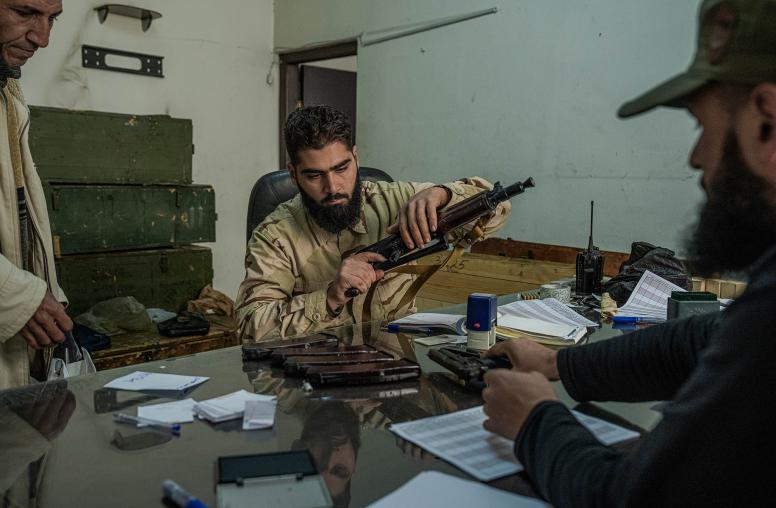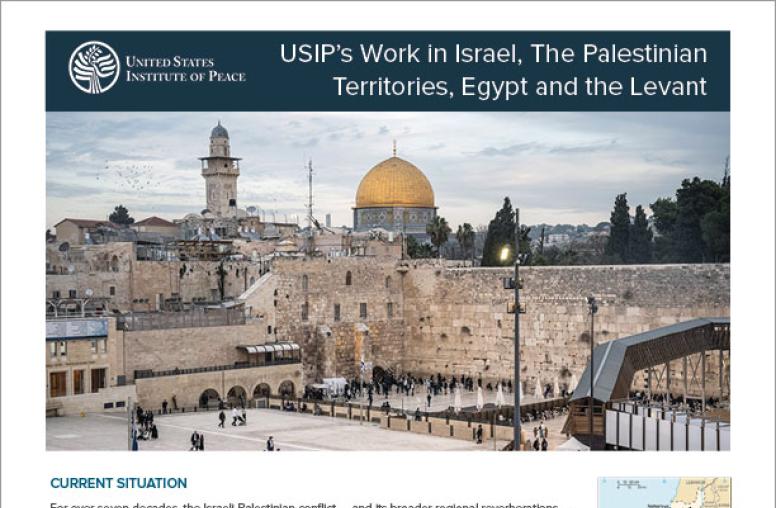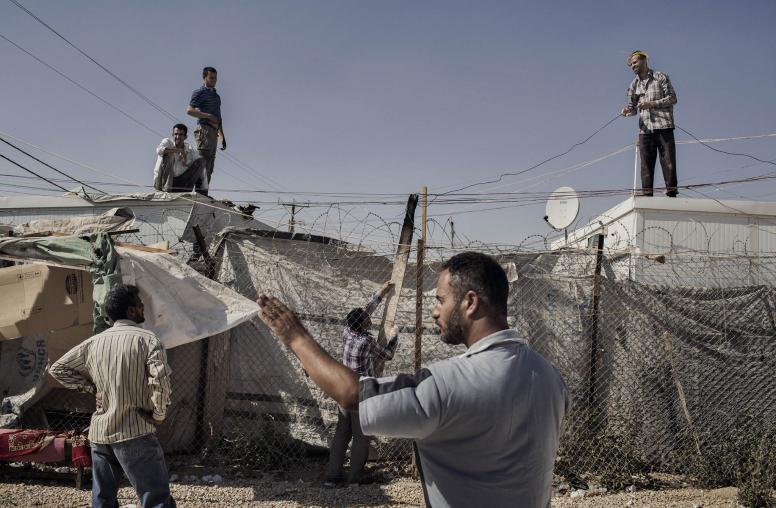The crosscurrents of conflict lay just beneath the surface when 14 religious, tribal and civic leaders from the al-Qahtaniya area of northeastern Syria first met last summer, brought together by a USIP project to ease communal tensions. By the time they and others reconvened four months later, the diverse group had shepherded the return of 100 families and won the reopening of a road vital to reaching markets nearby. In one corner of northern Syria, the threat of violent local conflict had receded.
The mass bloodshed of Syria’s civil war has spared many Kurdish and Arab towns in the country’s far northeast. But the war has aggravated overlapping political, religious and ethnic conflicts, including in the city of al-Qahtaniya and surrounding areas in the Kurdish-dominated region lying along the border with Turkey. It was these strains that the local leaders with their varying viewpoints addressed during three days of unprecedented talks in July in the city of Erbil. Supported by USIP and led by an experienced facilitator who conducts similar dialogues with USIP around the region, the discussion was organized in coordination with the Kurdistan Regional Government.
The work of the local leaders in al-Qahtaniya demonstrates for Syrians and others that alternatives to violence exist to resolve their differences.
In the course of the dialogue, which included an examination of the roots of the tensions, the group identified two projects that they felt would improve people’s lives and ease the strains that contributed to a risk of violence: Opening a road vital to the economies of surrounding villages, the majority of which are inhabited by Arab communities; and ensuring that families from one village could return after fleeing skirmishes with the self-styled Islamic State extremist group, also known as ISIL or ISIS.
The dialogue was modeled on others that USIP has supported in the region. One took place earlier this year in Iraq, where the institute and its local partners helped Sunni and Shia tribal leaders peacefully work through tensions over a 2014 massacre by the Sunni-dominated Islamic State group of some 1,700 Iraqi Shia military cadets around the Speicher military base. The result eased the return of thousands of families to the area of Tikrit after it was wrested from the control of the Islamic State group last spring.
A project to foster a local peace might seem quixotic amid the war in Syria, which has dragged on for almost five years, killed more than 250,000 people, displaced 12 million and lured in Iran, Russia, Turkey, Saudi Arabia and the U.S., among others. But the work of the local leaders in al-Qahtaniya demonstrates for Syrians and others that alternatives to violence exist to resolve their differences, said Elie Abouaoun, USIP’s director of Middle East programs. The approach of facilitating dialogue among disparate parties also provides a model for addressing underlying tensions that may re-emerge after the larger battles in Iraq, Syria and elsewhere are resolved.
“Small cases can be used in larger circumstances,” Abouaoun said. “It’s a way to illustrate how the cycle of violence works and its cost, and to promote a social transformation that shifts the paradigm from praise of violence as a solution -- a pattern that plagues the region -- to pursuing the culture of compromise.”
From August through November, the group met with local officials and others with a stake in the two issues. They argued that reopening the road, which Kurdish militia had closed for security reasons, would ease strains between Arabs and Kurds and that bringing the displaced families home would reduce tensions between two Kurdish political factions.
Political Will
The timing of their appeal also dovetailed with the needs of the area’s new governing administration, Abouaoun said.
"The Kurdish political party in charge is seeking to show it has matured and is capable of governing,” Abouaoun said. “They had an interest in building cohesion in the area with their Kurdish rivals and the Arab communities, especially in light of the continuing fight against ISIL. The political will was there.”
The politics of al-Qahtaniya are intricate. The administrative district had 65,685 residents in 2004, according to a Syrian census. The population in and around the city consists of Sunni Arabs, Kurds and minority groups, including Christians and Yazidis.
Since the Syrian uprising began in 2011, the area has gradually extracted itself from the control of the regime of Bashar al-Assad in Damascus. The regime withdrew from most of the district in 2012, leaving it under the control of the two major Kurdish political factions. As an autonomous region emerged, so did a power struggle between the two groups, the Democratic Union Party, known by its Kurdish acronym PYD, and the Kurdish National Council (KNC). The PYD ultimately gained control.
Relations between Kurds and their Arab neighbors have frayed amid frequent battles between Kurdish forces of the People’s Protection Unit (YPG), which is closely aligned with the PYD, and the predominately Sunni-Arab ISIL.
Suspicion among Kurds that local Arabs either collaborated or sympathized with the extremists prevented many Arab residents displaced in the fighting from returning to their homes. Compounding the strain, Kurdish nationalism and identity was favored by the new authorities in the same way Arab nationalism had been by the old.
Intra-Kurdish rivalries that fit into the Kurdish political landscape spanning Iraq and Turkey are another source of tension in the autonomous region. The PYD and its armed forces, the YPG, are closely aligned to the Kurdistan Works’ Party (PKK), the main Kurdish political and military group in Turkey. The KNC, meanwhile, is allied with the Kurdish Democratic Party (KDP), a dominant political faction in the Kurdistan Region of Iraq. The PKK and KDP have a rivalry playing out in Syria through their respective allies.
Religious Divides
Religious fissures also exacerbated tensions. In February 2014, ISIL attacked the predominately Kurdish town of Tal Marouf, located 25 kilometers south of al-Qahtaniya, where the Sufi stream of Islam is prevalent. The extremist group considers that form of the religion to be heretical. The assault displaced hundreds of families and destroyed infrastructure. After YPG forces cleared the town of ISIL fighters, many families stayed away, some because of religiously tinged political disputes.
One extended family, leaders of a major tribe in the area, was discouraged from returning because it was politically opposed to PYD. That, coupled with their link to a Sufi school of Islam that includes Arab co-religionists, raised suspicions among the PYD.
To ease these overlapping conflicts, the range of the 22 leaders ultimately involved in the dialogue project ensured that most of the communities would have a voice in the effort. Over four months, the group managed to work out the return of 100 families to Tal Marouf, including 60 associated with the PYD’s rival. And the PYD authorities agreed to reopen the road, helping the surrounding villages, including Arab-majority areas, connect with each other, reach key markets more quickly and interact with Kurds.
The leaders, assessing their efforts in late November, told USIP that they wouldn’t have been able to work together and understand each other’s perspectives without the guidance of the facilitated dialogue. After months of working together, the undercurrents of conflict that were so apparent at the first meeting in Erbil had dissipated, Abouaoun said.
Whatever the outcome of the larger war, conflicts among Syria’s tribal and communal groups will have to be managed. The work in al-Qahtaniya provides another example and a model for future efforts to stabilize Syria and the region.


